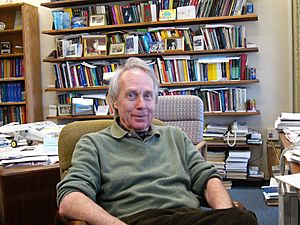Antony Jameson facts for kids
Quick facts for kids
Antony Jameson
|
|
|---|---|

Jameson in 2008
|
|
| Born | 20 November 1934 Gillingham, Kent, UK
|
| Alma mater | University of Cambridge |
| Known for | Jameson–Schmidt–Turkel scheme |
| Awards | Elmer A. Sperry Award (2006) FREng (2005) Fellow of the Royal Society (1995) Guggenheim Medal (2015) |
| Scientific career | |
| Fields | Computational fluid dynamics supersonic flows |
| Institutions | Stanford University Princeton University New York University |
Guy Antony Jameson is a brilliant scientist and engineer. He was born on November 20, 1934, in Gillingham, Kent, UK. He is famous for his amazing work in a field called computational fluid dynamics. This is a way of using computers to understand how liquids and gases (like air) move.
Professor Jameson has written over 300 scientific papers. These papers cover many topics, including how air moves around objects (aerodynamics) and how to control systems (control theory). He was recognized for his work by being elected to the National Academy of Engineering in 1997. He also received important awards like the Elmer A. Sperry Award in 2005 and the Daniel Guggenheim Medal in 2015. These awards celebrate his lifetime achievements in engineering and aeronautics.
Contents
Early Life and Education
Antony Jameson spent part of his childhood in India. His father was an officer in the British Army there. He went to school in India and later in England.
From 1953 to 1955, Jameson served as a lieutenant in the British Army. He was stationed in Malaya. After leaving the army, he worked at Bristol Aero-Engines for a summer. He then went to Trinity Hall, Cambridge to study engineering. He graduated with top honors in 1958. He continued his studies at Cambridge, earning a PhD in Magnetohydrodynamics. This is the study of how magnetic fields affect electrically conducting fluids.
Career in the UK
After his studies at Cambridge, Jameson worked as an economist for the Trades Union Congress for a short time. Later, he became the Chief Mathematician at Hawker Siddeley in Coventry.
Career in the United States
In 1966, Jameson moved to the United States. He joined the Aerodynamics Section at Grumman Aircraft Engineering Corporation in Bethpage, New York. Here, he focused on using automatic control theory. This helped improve systems that make aircraft more stable, like autopilots.
Around 1970, he started working on a big challenge: predicting how air flows at transonic speeds. This is when an aircraft moves close to the speed of sound. The computer methods at the time were not good enough. New ways of calculating these flows were needed. Computers were not powerful enough to model a whole aircraft. So, he focused on simpler shapes like airfoils (wing shapes) and wings.
In 1972, Jameson joined the Courant Institute of Mathematical Sciences at New York University. He continued his work on transonic flow there. He became a Professor of Computer Science at New York University in 1974.
Later, in 1980, he moved to Princeton University. By 1982, he was a distinguished professor of Aerospace Engineering. He also directed the university's program in Applied and Computational Mathematics for a few years. From 1997 to 2015, he was a Professor of Engineering at Stanford University. Today, he holds a special chair in Engineering at Texas A&M University.
How Computers Help Design Aircraft
Professor Jameson developed many new ways to solve complex math problems. These problems describe how air moves, both smoothly (inviscid) and with friction (viscous). He created methods like the multigrid-scheme for steady flows. He also developed the dual time stepping scheme for flows that change over time.
He also created computer programs called FLO and SYN. These programs have been used a lot in the aircraft industry. They help engineers design better airplanes by understanding how air flows around them.
Awards and Honors
Professor Jameson has received many awards for his important contributions:
- In 1980, he received the NASA Medal for Exceptional Scientific Achievement.
- In 1988, he won the Gold Medal from the British Royal Aeronautical Society. This was for his work on calculating transonic flow over real aircraft.
- In 1991, he became a Fellow of the American Institute of Aeronautics and Astronautics. He also became an Honorary Fellow of Trinity Hall, Cambridge.
- In 1993, he received the American Institute of Aeronautics and Astronautics Fluid Dynamics Award. This recognized his many contributions to computational fluid dynamics.
- In 1995, he was elected a Fellow of the Royal Society of London. This is a very old and respected scientific society.
- Also in 1995, the ASME gave him The Spirit of St. Louis Medal. This was for his work in computational fluid dynamics and the computer programs he developed.
- In 1997, he was elected as a Foreign Associate to the National Academy of Engineering.
- He received honorary doctorates from the University of Paris in 2001 and Uppsala University in 2002.
- In 2006, he received the Elmer A. Sperry Award.
- In 2005, he was elected a Fellow of the Royal Academy of Engineering.
- In 2015, he won the Daniel Guggenheim Medal. This is one of the highest honors for a lifetime of achievement in aeronautics.

